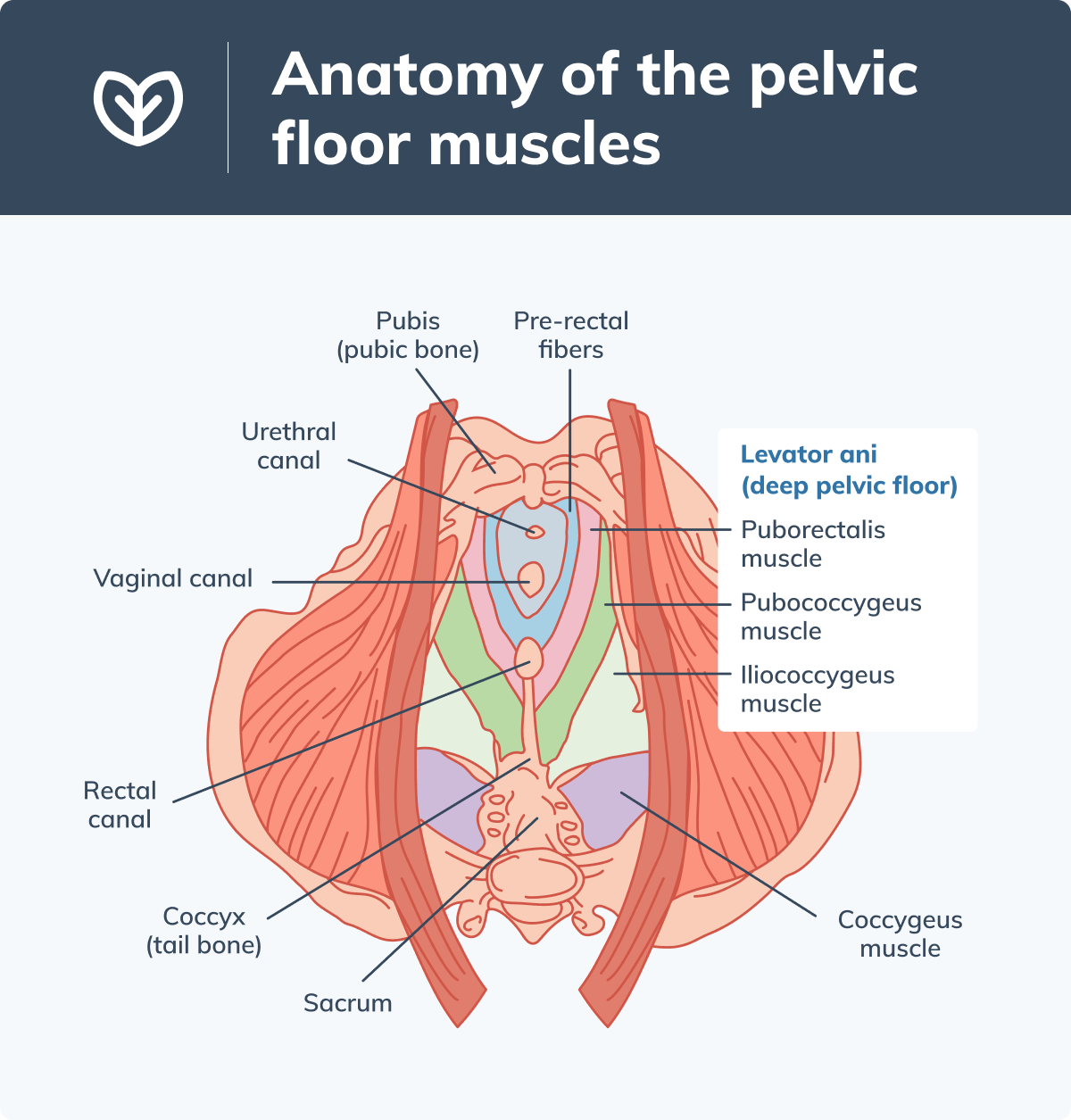Chances are you have heard of Kegel exercises (Kegels) for females of childbearing age, but did you know that there are also benefits for men and children to complete these exercises? The pelvic floor is credited as first being described by Dr. Arnold Kegel in 1948, along with the need to perform exercises to strengthen and support it, hence why these exercises are called Kegel exercises. (3)
Kegel exercises are used to strengthen the pelvic floor muscles (Kegel muscles) in males, females, and children. These exercises can be done either as a preventive method or as a way to strengthen pelvic muscles and treat pelvic floor weakness. Kegel exercises have been shown to have a positive impact on bladder leakage, bladder prolapse (dropping of the bladder from its original position), (3) and the sudden urge to urinate. (8) Our pelvic floor muscles extend to the back of our bodies, so doing these exercises can also assist with relieving gas or passing of stool. (4) In addition to assisting with bladder and bowel control, Kegel exercises have been shown to improve sexual function in both males and females. (3)(7)
Whether you are looking to avoid these symptoms or simply strengthen your pelvic floor muscles for overall health, there are many benefits of kegel exercises. As Kegel exercises can be done very discreetly, they can easily be done throughout your day without anyone knowing it!
What are pelvic floor muscles?
The pelvic floor muscles are the muscles that support the base of our abdomens and our rectal, vaginal (female), and urethral (male) openings. The pelvic floor is made up of the acrum, ileum, ischium, and pubis bones, which are then covered in layers of muscles that support these functions. (11) The pelvic floor muscles essentially create a sling of muscles that run from the front of your body to the back, connecting your pubic bone and your tailbone. (3) The strength of these muscles is essential for urinary function, preventing bladder and anal leaking and gas release. (4)

What are Kegel exercises, and why do they matter?
Kegel exercises or pelvic floor muscle exercises are exercises that can be done regularly to strengthen the Kegel muscles. These exercises consist of contracting and relaxing these muscles to build strength. (4)(6)
There are many events or factors that can lead to weak pelvic floor muscles, which can lead to bladder and bowel problems such as leakage (fecal and urinary incontinence). (8) Some of the main factors that can weaken your pelvic muscles are:
- Aging
- Cesarean section (C-section)
- Chronic (long-term) constipation
- Chronic (long-term) cough
- Genetics
- Hysterectomy (surgical removal of the uterus)
- Menopause
- Pregnancy and childbirth
- Surgery near the pelvic area
- Weight gain (3)(9)

Benefits of Kegel exercises
Though most commonly known to support women, Kegel exercises can benefit males and children as well. The benefits of kegel exercises vary depending on sex and age. As with adults, children can benefit from doing pelvic floor exercises, but caution should be taken to avoid overworking these muscles as it can lead to straining when children are trying to use the washroom. (6)
Benefits for females
Pelvic floor exercises are done to strengthen and support your pelvic floor muscles and prevent the uterus, bladder, and bowel from lowering, which may lead to a condition known as pelvic floor prolapse. By completing Kegel exercises, females can keep these muscles strong and support bladder function by reducing leakage and avoiding accidental stool or gas passing. Kegel exercises have also been known to improve the feeling of orgasms and sexual arousal. (10)
As pelvic floor muscles can weaken with age by carrying a child, during childbirth, or after a C-section, females during or past childbearing years can regain some of the strength of these muscles by completing kegel exercises. (1)(12) For females during childbearing years, Kegel exercises can be done during pregnancy as well as after to support urinary and bowel function. (2)
Research has also shown that Kegel exercises can improve sexual function for females, especially those post-menopause. Completing Kegel exercises has been shown to improve sexual arousal, orgasms, and overall sexual satisfaction for women after menopause. (9)
While there are many benefits, it’s important not to perform Kegel exercises excessively. This can lead to straining while using the washroom. (6)
Benefits for males
There are two main muscles that make up the pelvic floor muscles: the levator ani (which helps to “lift the anus” and is the deeper layer of muscle) and the coccygeus or ischiococcygeus muscle. The levator ani is composed of three, smaller muscles: puborectalis, pubococcygeus (PC), and iliococcygeus (IC). There is also a more superficial layer of muscle called the perineal muscles, one of which includes the bulbocavernosus (BC) muscle. Each of these muscles plays an important role in the male body, and performing Kegel exercises is a way to support them. (8) As well, it has been shown that completing Kegel exercises can reduce the chance of premature ejaculation in males. (5)(7)
BC muscles benefit most from kegel exercises. These muscles are used when pushing semen and urine through the urethra and pushing blood down to the end of the penis. (8)
PC muscles are involved in bladder function and bowel movements. The largest muscles of the pelvic floor, PC muscles not only contract during orgasm but support organs lower in the abdomen.

IC muscles support the retraction of the anus after a bowel movement. (8) As with females, it’s important not to do these exercises in excess due to the risk of straining while using the washroom. (6)
How to do Kegel exercises
Though there are slight variations in how to find the Kegel muscles for males and females, once you find the muscles, the exercises are very similar!
How to find your Kegel muscles for males and females
There are several ways to find your Kegel muscles. Once you have figured out how to find these muscles and exercise them, you are well on your way to completing Kegel exercises. Here are a few ways to find your pelvic floor muscles.
- Stop your urine stream while urinating. Though this should only be done to learn where the muscles are, as doing regularly stopping urination can lead to health problems such as urinary tract infections.
- Prevent passing gas (3)(6)
For females, there are a few additional ways to find these muscles.
- Inserting a tampon into your vagina and squeezing your muscles around it
- Inserting a finger into your vagina and squeezing your muscles around it (6)
Once you’ve identified the correct muscles, you can complete Kegel exercises by tightening these muscles to a count of three, then releasing them for another count of three. To complete a full set of these exercises, complete the hold and release ten times while standing, sitting, or lying down.
To get the most benefit from these exercises, they should be incorporated into your daily routine and completed at least two times a day. If you find that your pelvic floor muscles are particularly weak, starting this exercise while lying down is recommended. (6)
The bottom line
Though most commonly thought of as an exercise for females in the years after childbirth, Kegel exercises can support anyone regardless of sex or age. Completing these exercises on a regular basis can strengthen pelvic floor muscles and improve continence (bowel and bladder control) in females, males, and children. When performed correctly, these exercises can support your overall health, prevent bladder and anal leaking, and improve sexual function. (6)(7)
If you’re unsure if Kegel exercises are for you or if you’re doing them correctly, always check with your healthcare provider.
- Bhat, G. S., & Shastry, A. (2022). Sexually Induced Orgasm to Improve Postpartum Pelvic Floor Muscle Strength and Sexual Function in Primiparous Women After Vaginal Delivery: A Prospective Randomized Two-Arm Study. The Journal of Sexual Medicine, 19(11), 1634–1643.
- Harvey, M. A. (2003). Pelvic Floor Exercises During and After Pregnancy: A Systematic Review of Their Role in Preventing Pelvic Floor Dysfunction. Journal of Obstetrics and Gynaecology Canada, 25(6), 487–498.
- Huang YC, Chang KV. Kegel exercises. In: StatPearls . StatPearls Publishing. Updated May 9, 2021. www.ncbi.nlm.nih.gov/books/NBK555898
- Inge Bernstein. (1996). The pelvic floor muscles: Muscle thickness in healthy and urinary-incontinent women measured by perineal ultrasonography with reference to the effect of pelvic floor training. Estrogen receptor studies. Neurourology and Urodynamics.
- Jiang, M., Yan, G., Deng, H., Liang, H., Lin, Y., & Zhang, X. (2019). The efficacy of regular penis‐root masturbation, versus Kegel exercise in the treatment of primary premature ejaculation: A quasi-randomised controlled trial. Andrologia, 52(1).
- Kegel Exercises. (2022, August 30). National Institute of Diabetes and Digestive and Kidney Diseases. https://www.niddk.nih.gov/health-information/urologic-diseases/kegel-exercises
- Myers, C., & Smith, M. (2019). Pelvic floor muscle training improves erectile dysfunction and premature ejaculation: a systematic review. Physiotherapy, 105(2), 235–243.
- NAFC. (2022, October 18). KEGELS FOR MEN. National Association for Continence. https://nafc.org/kegel-exercises-for-men/
- Nazarpour, S., Simbar, M., Ramezani Tehrani, F., & Alavi Majd, H. (2017). Effects of Sex Education and Kegel Exercises on the Sexual Function of Postmenopausal Women: A Randomized Clinical Trial. The Journal of Sexual Medicine, 14(7), 959–967.
- Park, S. H., Kang, C. B., Jang, S. Y., & Kim, B. Y. (2013). Journal of Korean Academy of Nursing, 43(3), 420–430.
- Raizada, V., & Mittal, R. K. (2008). Pelvic Floor Anatomy and Applied Physiology. Gastroenterology Clinics of North America, 37(3), 493–509.
- Yount, S. M., Fay, R. A., & Kissler, K. J. (2021). Prenatal and Postpartum Experience, Knowledge and Engagement with Kegels: A Longitudinal, Prospective, Multisite Study. Journal of Women’s Health, 30(6), 891–901.





